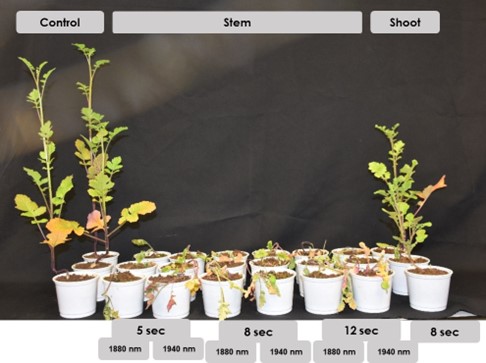Gilad Marcus, Applied Physics Institute, Hebrew University
Salman Noach, Jerusalem College of Technology,
Avital Bechar, Volcani Institute, Ministry of Agriculture and Rural Development.
Ran Lati, Volcani Institute, Ministry of Agriculture and Rural Development.
Abstract
An autonomous lightweight weeding system that identifies and targets weeds for shooting a suitable irradiation beam for weed elimination.
Background
What is the domain of the invention or the technology (? What problem is addressed? Why it is critical? What are the current challenges in this area?
Weeds are the most significant biotic factor limiting agricultural crops. Weeds compete with cultivated plants for water, nutrients, light, and reduce global agricultural yields by ~10%. Chemical herbicides are the main tool used to control weeds today. The use of these substances provides effective pest control, however, some substances have been found to have negative health effects on humans and the environment As such, there is public pressure on legislators to limit their use.
Indeed, many chemical herbicides have been banned for use in Israel and around the world – additional herbicides may be banned for use in the future. Moreover, selection pressure following repeated application of herbicides with a similar mechanism of action leads to the development of herbicide resistant weed populations. These two trends reduce the weed control options available to farmers and endanger the continued supply and global food security. Therefore, it is necessary to develop and adopt alternative weed control approaches that maintain a high level of production while reducing the use and heavy dependence on herbicides.
Sensing and data processing technologies that exist today enable the application of precise (site specific) pest control, by automatically identifying individual weeds and quickly directing the pest control measures to the grass. Spot and precise treatment of weeds allows the use of non-selective herbicides without harming the cultivated plants.
Using a suitable beam is a non-chemical alternative to deal with weeds that offers the highest levels of precision. The energy of the beam damages plants by pyrolysis (decomposition by heating) or cutting. The effectiveness of the impact depends on technical parameters such as the diameter of the beam, the wavelength and of course the exposure time (number of pulses). Pyrolysis heats the area where the beam hits, thereby causing an increase in water pressure in the cells, tearing of the membranes and finally death or retardation of development.
Despite the great potential inherent in the beam for effective and precise extermination of weeds, as of this moment, its use is still limited. Previously high energy levels required for effective control and the long exposure time limited the use of this method in large scale applications. Current solutions that are under development are bulky and heavy, causing negative impact on soil compression, have a high energy cost and reduce the economic viability of this method. There is a need to find new technological solutions that will make energy-based weed control more efficient in terms of energy and treatment time.
Our Innovation
State in one sentence what is the invention. (Method, new target, new approach, new software)
- List in bullet points 3-5 major advantages in terms of technological and functional excellence; if possible, in comparison to existing practice
Technology
Briefly describe the approach and the method proposed. Integrate images, if relevant
The researchers use a pulsed irradiation wavelength tuned to absorption line of the water in the weed. We focus the whole energy into a small vulnerable spot on the weed, causing an irreversible damage to the weed with reduced amount of energy, thereby reducing the required power and lowering power consumption and weight. It opens the possibility to put everything on a small, lightweight, and chip autonomous vehicle. It will enable a true solution for an autonomous weeding system.
In the following figures we show the results of our preliminary weed control tests.

Fig.1: Application of our system on Solanum nigrum cutting downapproach. The red arrow indicates the spot at which the beam hits the weed

Fig.2: The consequences of laser treatments on Solanum nigrum growth (3, 6, and 10 second of exposure):

Fig.3 The consequences of treatments on Brassica nigra growth using suitable wavelenghs and durations:

Fig 4. An FlIR image captured during treatment to Brassica Nigra from the very first seconds (up left) till the weed cutting (down right). The green square indicates the point at which the laser hit the weed stem. Saturation (white/yellow) indicates temperature above 120 degrees Celcius.
Opportunity
What is the expected impact or additional applications, if possible? Consider to relate to the way the technology strengthens the competitiveness and growth of companies by developing innovations, meeting the needs of specific markets or populations.
The researchers are looking for an industry partner to continue refining this technology and to bring this technology to market.
